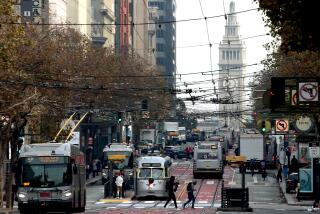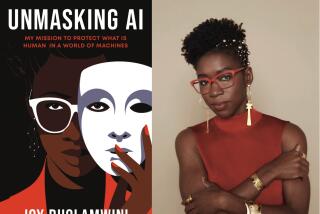Google’s Thomas Williams finds creativity in computers
The gig: In addition to being a senior engineering director at Google Inc., 47-year-old Thomas Williams is the site director for the company’s newly opened 500-person campus near Venice Beach, where it develops video advertising for YouTube, pieces of the Google+ social network and the Chrome Web browser. After sifting through a pool of hundreds of potential properties for Google’s L.A. location, Williams and his team settled on Frank Gehry’s Binoculars Building, and redecorated the interior with touches that mixed Google’s whimsical design tastes with hallmarks of Los Angeles culture. When it opened last month, the office sported plush conference rooms with names like the Hollywood Sign, a row of surfboards for engineers to take to the nearby beach, a juice bar and a cafe with a rotating art gallery.
Technology calls: Williams, who grew up in New Jersey, had a brush with the future when he was 11. One evening his best friend’s father, who worked at nearby Bell Labs, the storied AT&T-owned research facility, brought home a curious device: a typewriter with a telephone attached to it. The attachment allowed the typewriter to send bits of information back and forth to a mainframe server — a precursor to a networked personal computer. Williams and his friend typed in simple math problems and watched as, moments later, the typewriter clacked out the solution. “Seeing these little equations get solved was the thing that hooked me — it was kind of like magic,” he said.
Plotting the future: As a computer science major at Villanova University, Williams wrote a software program he dubbed “gnuplot.” The program was one of the first to allow users to produce visually appealing graphs from scientific data. Gnuplot quickly caught on with scientists and students at universities around the world. It is still in wide use today, including at Google, where engineers use it to monitor the performance of data center servers. “The thing I learned was, find something that was really useful and make it really simple for anyone to use,” Williams said. Using technology to create art and graphics would occupy much of his career.
A job with Jobs: After a stint at the Analytic Sciences Corp., a Massachusetts think tank, Williams moved to the Bay Area looking for work. One of his first interviews was with Steve Jobs, then at Next Computer, the company that Jobs founded after being ejected from Apple in 1985. During the interview, “Steve took off through the building and started yelling at someone who was much smarter than me,” Williams said. “I realized I probably wouldn’t get the job, and that I probably didn’t want it.” But Williams ended up working for Jobs anyway — the next day he interviewed at Pixar Animation Studios, which Jobs had just bought from George Lucas. After being hired, Williams began to work on a project called RenderMan, the computer graphics software that Pixar used to create its string of hit animated films, including “Toy Story” and “Finding Nemo.”
Computers for cavemen: After Pixar, Williams moved to a visual effects firm, Lucas’ Industrial Light and Magic. At that point ILM still largely built creatures and models out of physical materials (think spaceships in “Star Wars” or puppets in “The Dark Crystal”). “No one really cared about computer graphics that much yet,” he said. At that time, computer scientists had to laboriously write programming code to create digital animation — there was no easy way for traditional artists to create lifelike figures with computers. One day, though, Williams watched one of his non-technical art directors at ILM hand-paint a Gallimimus dinosaur in a few hours. Struck by how effortlessly it was done, Williams said, “How do you do that?” The artist said, “I’m just a caveman — I push mud around with a stick.”
That was a light bulb moment for Williams, who said, “Exactly! We need more cavemen!” It was then that he set about hiring a team to build digital modeling and painting tools that regular artists could use without having to know the math and science behind computer animation. Using those tools, he built ILM’s digital-effects arm, which produced groundbreaking graphics scenes for films such as “Terminator 2: Judgment Day,” “Forrest Gump” and “Jurassic Park,” all three of which won Academy Awards for special effects.
Use your hands: In his personal life, Williams says he regularly gets obsessive about mastering new crafts, whether it’s creating homemade circuit boards with acid-etching techniques, making sourdough bread using yeast he grew himself, or woodworking. He built a 12-foot sailboat in his garage and helped a group of artisan carpenters build a house in Montecito using only Renaissance-era materials and hand tools. But to Williams, craft is the same, whether it’s creating software or building boats. “It’s personal expression. People don’t think of writing a program the same way as they do writing a book or poem, but it’s a creative process. There are rules, and when it’s flawed you have to go back and change it.”
Build your own treadmill: Williams has a craftsman-like metaphor for how to help people excel, one that he has applied at Pixar, ILM and now Google. Instead of allowing employees to get mired in jobs that become endlessly repetitive — like hamster wheels — you get them to “build their own treadmills.” That means giving people the latitude to figure out problems in new ways and to work at their own pace. “If you work with great people, everyone is setting their treadmill too high. No one’s telling you you’re not going fast enough — everyone is telling themselves that.”






